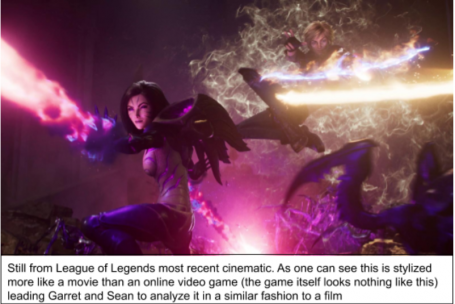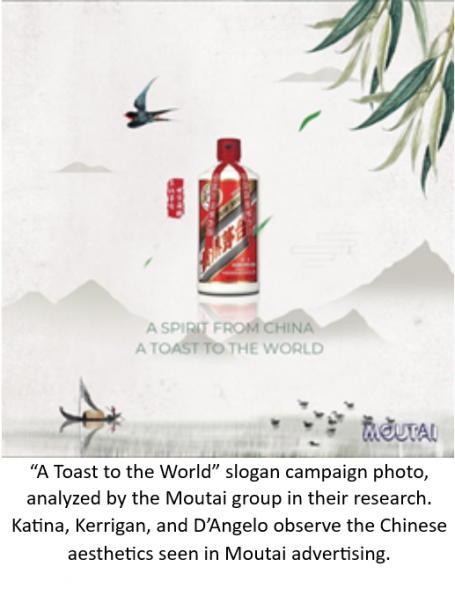Sarah Kim & Keegan Smit
Hey y’all, it’s Keegan and Sarah here to give an update and overview on how the League of Legends (LoL) and Moutai group have developed their final research project in the past week. Each group has experienced very different journeys this week, so we’ll discuss each project separately:
League of Legends – covered by Keegan
After finishing presenting their research design to the class, and taking a much needed weekend rest, Sean and Garrett decided to focus on three cinematic worlds of LoL, those from 2017, 2018, and 2019.
For those unfamiliar with League (as the kids call it), it is an online, battle-arena strategy game that connects gamers from across the globe. At the end of the year, LoL hosts a world championship game. Leading up to this event, the company releases a cinematic advertisement to hype up the competitors and game enthusiasts, as well as attempt to advertise the product itself.
The group’s initial question focused on themes between these worlds (the video advertisements), but Sean and Garrett ultimately chose mid-week to revise their question to analyze the storyline and narratives, rather than just the themes. From this new question, the team drafted a rough thesis: “Riot owned business, Tencent, uses engrossing cinematics and evolving storylines inspired by the classical story of achieving greatness to immerse their audience while integrating themes of hardship, adversity, and individuality through the usage of their in-game character.” Although this was a great start, the group saw that the thesis they had drafted did not necessarily align with the entire scope and direction of their paper after meeting with Professor Sheehan on Friday. Their thesis required some rearrangement for clarity, specificity, and to best match their already written analysis. The final thesis they developed states, “Riot, owned by Tencent, uses engrossing cinematics, integrating themes of individuality and overcoming hardship and adversity to achieve greatness while simultaneously developing these promotional videos to include the evolution and history of LoL and its global consumers.” This new thesis gave them the last building block to push forward with constructing their paper, which the group expected to have finished on the 6th so that they could have ample time to revise their work and finish their presentation.
I know I speak for all of the Global East Asia China class when I say we really look forward to seeing how their final project turns out in their recorded presentation. Best of luck, Sean and Garrett!
Moutai – covered by Sarah
I should warn everybody reading this blog post to not be too shocked by how put-together this group is. But before I get into Katina, Kerrigan, and D’Angelo’s progress, here’s a little bit about Moutai, which is probably much less known than League.
Moutai, or more specifically the company Kweichow Moutai, is “the world’s most valuable Chinese liquor company and manufacturer of one of the most popular alcoholic drinks, Moutai baijiu,” as the Moutai group explains in their paper.
Their research question is an interesting one: “We are studying how the Moutai brand, a product so integrated into Chinese culture, orients its marketing to appeal to an English speaking audience to understand the international marketing of brands with heavy cultural connotations.”
The other groups in our class – TikTok, League, and Shein – all have marketing that isn’t clearly culturally tied to China, which makes Moutai really stand out as a company that seems to embrace and take advantage of Chinese cultural attributes.
On Monday, Katina, Kerrigan, and D’Angelo had already composed an outline and were in the process of creating a rough draft to present to Prof. Sheehan for our Tuesday calls.
As you can see, the draft is composed of fully paragraphed analyses, thoughtful headings, and formal citations!
Throughout the week, there were two calls with Prof. Sheehan where the Moutai group discussed their thesis statement and adding a “so what” component. After much deliberation, Katina, Kerrigan, and D’Angelo decided on this thesis: “By analyzing advertisements intended for a Chinese audience besides those intended for a global audience, we have found that, while Moutai appeals to national pride when dealing with a Chinese-speaking audience, Moutai instead appeals to a desire for exotic experiences and an association with Chinese culture.”
By Friday, the Moutai group had the larger part of their essay finished, but they wanted to further examine what stereotypes were being used in the Moutai advertisements used in China vs those intended for a global audience.
We will be able to see all of their work in the form of a presentation in the next few days!





